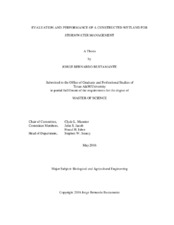| dc.description.abstract | The Dickinson Bayou Watershed has several water bodies impaired by high fecal coliform counts and low oxygen levels. Total Maximum Daily Loads (TMDL) were developed to estimate the maximum amounts of Escherichia coli (E. coli) the tributaries to Dickinson Bayou could receive and still meet water quality standards. As part of the Dickinson Bayou Watershed Protection Plan, the Clear Creek Independent School District (CCISD) in League City, Texas, together with the Texas Coastal Watershed Program (TCWP-part of TAMU) office, retrofitted a detention pond in the their Education Village into a constructed wetland. This research seeks to evaluate the retrofitted constructed wetland effectiveness in reducing effluent loads of E. coli and how it compares to the potential load reduction estimated in the Total Maximum Daily Load (TMDL). Inflow into the wetland was quantified using the SCS Curve Number method and outflow was quantified using the stage-storage curve based on the change of the water level in the wetland. Inflow and outflow water samples were collected using ISCO samplers and tested with 3M^TM E. coli/ Coliform Petrifilm^TM. E. coli concentrations were analyzed following the methods outlined by the International BMP Database and using the XLSTAT software. The statistical analysis included descriptive statistics and parametric and non-parametric hypothetical testing. The results showed a median E. coli inflow concentration of 5,987 CFU/100ml and a median outflow concentration of 1,500 CFU/100ml. The normalized E. coli load was calculated to be 2.0 x 10^10 CFU/acrexyr. A comparison to similar BMPs using lognormal probability plots showed the Education village compared favorably at high inflow concentrations, but had a higher minimum achievable concentration. The analysis of BMP performance data is often complex and challenging. Due to the limitations of this study there are a many avenues of further research. First, the influent E. coli concentrations were significantly higher than comparable watersheds. Considering the Education Village watershed only contains institutional facilities, high E. coli concentrations were not expected. Another possible investigation could involve taking a more detailed hydrograph and pollutograph. Moreover, more studies at other BMPs are needed for a better comparison of treatment performance, especially at detention basins. Finally, while this research highlights the possibility of a loading reduction that is lower than the WPP estimate, more research is needed to confirm that estimate. | en |


